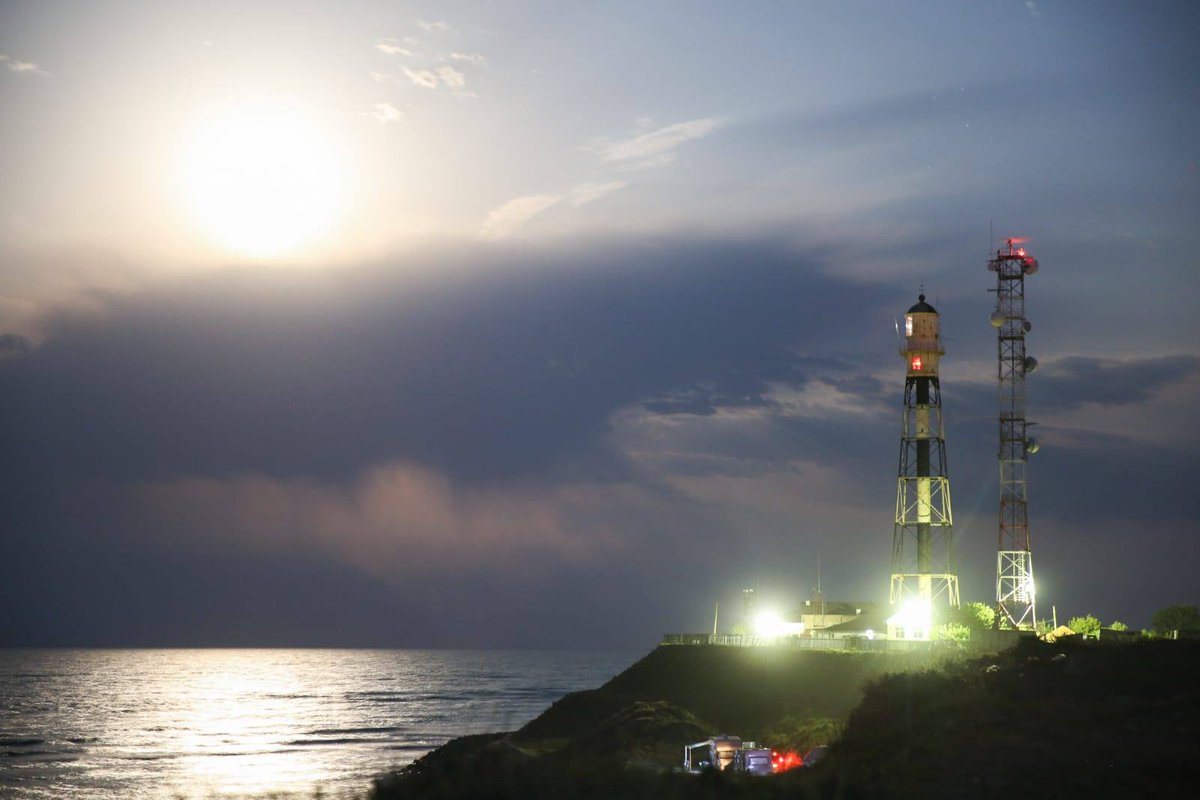Tuzla Lighthouse
IALA Heritage Lighthouse of the Year 2025 Nominee
Location: ROMANIA Constanța County, Capul Tuzla (near Eforie Sud)
Lighthouse Operator: Maritime Hydrographic Directorate of Romania

Lighthouse Description and History
(Text extracted from nomination form submitted by Maritime Hydrographic Directorate of Romania, 2025)
Tuzla Lighthouse is the oldest active lighthouse on the Romanian coast, constructed in 1900 by the French company Barbier, Bernard et Turenne. Located on Cape Tuzla, overlooking the Black Sea, the 44-meter-high cast iron skeletal tower features black and white horizontal bands and originally used oil lamps before being electrified in 1958. It was upgraded in 1946, 1957, and 1972. The lighthouse emits two white flashes every 9.7 seconds, visible up to 20 nautical miles, and includes an auxiliary red light and a fog signal. Built during the reign of King Carol I, it has played a crucial role in maritime safety, marking dangerous shallow waters along the coast.
Reason For Nomination
(Text extracted from nomination form submitted by Maritime Hydrographic Directorate of Romania, 2025)
Intrinsic Heritage Interest of the Lighthouse
Tuzla Lighthouse is exceptional as Romania’s oldest continuously operational lighthouse, dating back to 1900. Prefabricated in France, it reflects early 20th-century European engineering excellence through its cast iron skeletal design. The 44-meter tower, marked by its distinctive black and white horizontal bands, stands today as a rare surviving example of prefabricated maritime architecture; a model that has influenced similar lighthouse structures worldwide.
Historically, the lighthouse has played a vital role in safeguarding navigation along the Black Sea coast, particularly near the treacherous headlands of Cape Tuzla. It is deeply associated with Romania’s maritime heritage and the broader evolution of navigational aids, from oil lamps to modern electrification.
Culturally, Tuzla Lighthouse symbolizes coastal resilience and national pride. It has been featured in Romanian philately and literature, reinforcing its status as both a functional landmark and a cultural icon. Its fog signal and sector lights exemplify early innovations in navigational safety, making Tuzla not just a beacon for mariners, but a unique testament to the intersection of engineering, history, and identity in the context of global lighthouse development.
Conservation
Tuzla Lighthouse remains in good operational condition and is actively maintained by the Maritime Hydrographic Directorate, with periodic upgrades ensuring its continued functionality. Despite this, the site faces significant threats from severe coastal erosion, which endangers the stability of the coastal platform at Cape Tuzla where the lighthouse stands.
Conservation efforts have included the reinforcement of the coastal area in 2009 to stabilize the site. Additional measures have been recommended, such as the construction of erosion protection structures to safeguard the lighthouse from further shoreline degradation.
There are long-term plans to relocate the tower further inland to protect it from ongoing shoreline retreat; however, implementation has been delayed due to funding constraints. At present, the lighthouse does not serve any alternative uses, as its primary role remains that of a vital navigational aid. Nevertheless, its preservation indirectly supports cultural tourism and public interest in maritime heritage.
Ongoing monitoring by Romanian authorities, along with potential future collaboration at national or international level, aims to ensure the long-term conservation of this historically and functionally significant structure, especially in the face of increasing climate-related coastal challenges.
Public Access and Education
Tuzla Lighthouse continues to serve not only as a navigational aid, but also as a cultural and educational landmark within the region. Although it does not offer regular public access, the site becomes available to visitors on select occasions throughout the year—such as during “Open Gates” events and other educational site-centered programs. These initiatives allow the public to engage directly with Romania’s maritime heritage in a guided and informative setting.
The lighthouse has gained broader visibility through philatelic releases by Romfilatelia and dedicated content on official platforms, contributing to national awareness of its historical significance. Educational outreach is further enhanced by the Maritime Hydrographic Directorate, which offers online resources detailing the lighthouse’s structure, history, and function within the wider system of aids to navigation.
Regionally, Tuzla is sometimes featured in tourism and cultural programs across Constanța County, where coastal tours may include the lighthouse as a key stop. Moreover, the site plays an active role in environmental and heritage education efforts, helping to promote public understanding of both maritime infrastructure and the importance of preserving coastal cultural assets.
Other Reasons Why the Nominated Lighthouse Would Promote World Lighthouse Heritage
Recognizing Tuzla Lighthouse would bring critical attention to erosion-threatened coastal heritage in the Black Sea region, encouraging global dialogue on the conservation of maritime landmarks in the face of climate change. As a rare example of a French-prefabricated lighthouse situated in Eastern Europe, Tuzla represents a unique intersection of Western engineering and Eastern maritime legacy, bridging diverse historical narratives.
Its designation could serve as a catalyst for international cooperation and inspire funding models for the relocation and protection of similarly endangered sites worldwide. Furthermore, such recognition would enhance the visibility of global heritage efforts in underrepresented regions, fostering stronger engagement in maritime preservation.
Ultimately, promoting Tuzla Lighthouse at a global level would elevate the appreciation of lighthouses not only as navigational aids but also as enduring cultural symbols and sentinels of environmental resilience.
